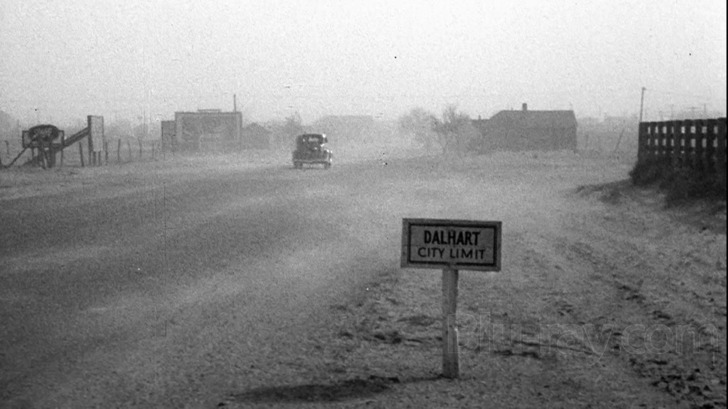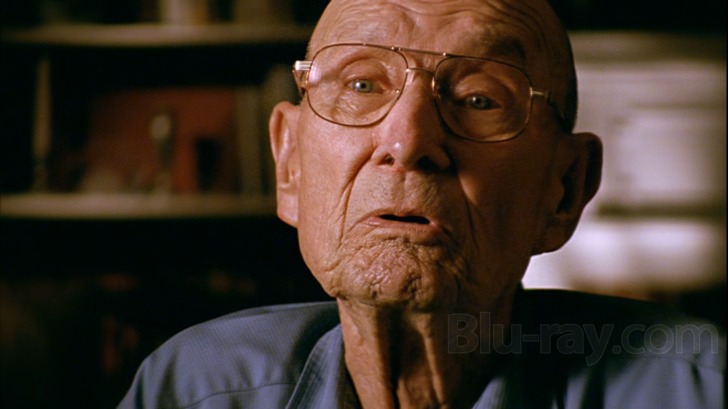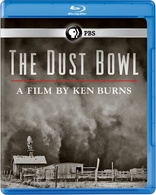The Dust Bowl Blu-ray Movie
HomeThe Dust Bowl Blu-ray Movie 
Ken BurnsPBS | 2012 | 228 min | Not rated | Nov 20, 2012
Movie rating
7.6 | / 10 |
Blu-ray rating
| Users | 5.0 | |
| Reviewer | 3.5 | |
| Overall | 3.9 |
Overview
The Dust Bowl (2012)
Chronicles the worst man-made ecological disaster in US history when a frenzied wheat boom on the southern Plains followed by a decade-long drought during the 1930s nearly swept away the breadbasket of the nation. Menacing black blizzards killed farmers' crops and livestock threatened the lives of their children and forced thousands of desperate families to pick up and move somewhere else.
Narrator: Peter CoyoteDirector: Ken Burns
| Documentary | 100% |
| History | 41% |
Specifications
Video
Video codec: MPEG-4 AVC
Video resolution: 1080i
Aspect ratio: 1.77:1, 1.78:1
Original aspect ratio: 1.78:1
Audio
English: Dolby Digital 5.1 (640 kbps)
English: LPCM 2.0 (48kHz, 16-bit)
Spanish: LPCM 2.0
Subtitles
English SDH, Spanish SDH
Discs
50GB Blu-ray Disc
Two-disc set (2 BDs)
Playback
Region A (locked)
Review
Rating summary
| Movie | 4.0 | |
| Video | 3.5 | |
| Audio | 4.0 | |
| Extras | 3.5 | |
| Overall | 3.5 |
The Dust Bowl Blu-ray Movie Review
The land chokes as the money dries up.
Reviewed by Brian Orndorf November 16, 2012When a documentary from Ken Burns steps into view, certain expectations are triggered that would never apply to a routine production. Building a golden reputation with his work on “The Civil War” and “Baseball,” Burns supplies a certain regality to his efforts that’s blended with a sensational amount of textured information, creating unforgettable portraits of American life and conflict. “The Dust Bowl” furthers his interests in the fragility and fortitude of the country. Inspired by work from author Dayton Duncan, Burns launches into one of the most catastrophic periods in the nation’s history -- a man-made environmental disaster that coincided with an extended period of financial ruin, with both mighty forces punishing the pioneer spirit that once defined life in the U.S. As anticipated, Burns doesn’t approach the subject from an academic point of view, electing to manufacture a sense of community, focusing on the families that established residency inside the difficult expanse of the Southern Plains, supplying detailed memories of life in the Dust Bowl, with all its tragedy, discomfort, and desperation. It’s a harrowing, mournful documentary that definitely doesn’t shy away from the misery of the moment. However, a sense of time and place is established magnificently, carrying the viewer through a tattered, dust-caked landscape of buried agricultural ambition, gracefully detailing an arduous way of life that some suggest might one day return to haunt the heartland.

Disc One:
“The Great Plow Up” (113:12, Airdate – 11/18/12)
In the ever changing quest to expand America’s financial appeal and provide opportunities for its citizens, the Great Plains were viewed as a golden opportunity for development, with unscrupulous land owners promising a bright farming future for those willing to relocate to the environmentally erratic grasslands. The “No Man’s Land” area is the particular study of this episode, following the vast amount of European immigrants as they carried their families to the panhandle area of Oklahoma on a mission to seize a life of prosperity. Wheat was the initial crop that caught the country’s attention, with farmers offered large amounts of money to keep up with demand after WWI, undertaking considerable effort to plow the delicate sod of the region and grow their fortune. It wasn’t just homesteads on the hunt for coin, but “Suitcase Farmers” as well, money men buying up huge areas of land to cash in on the crop craze, expanding the power of the plow. After the 1929 Stock Market Crash, the area went “Wheat Mad,” with farming efforts doubled as fortunes were beginning to take shape, doubling developed acreage to keep profits sky high.
In the 1930s, this tremendous effort to manipulate risky land resulted in the commencement of dust storms or “Dust Blizzards,” which swallowed Middle America with a vengeance, taxing even the most determined farmer hoping for a better tomorrow. The storms destroyed domestic routine and decimated the landscape, killing cattle and crop growth, while introducing “dust pneumonia” to the populace, as dust particles worked their way into lungs, creating crippling health problems. As the Depression crawled across the country, No Man’s Land was decimated by financial ruin, hungry jackrabbits (necessitating “rabbit drives” to slaughter them all), and death, finding suicide a popular exit for those facing foreclosures and tragedy. While the New Deal attempted to restore life to the farmlands, hope was running out, with dust storms increasing in power throughout the decade, leaving some to greet their relentless power as an act of Godly punishment, peaking with the wreckage of “Black Sunday” and the reflections of one of its survivors, Woody Guthrie.
Disc Two:
“Reaping the Whirlwind” (114:22, Airdate – 11/19/12)
As the ecological catastrophe intensified throughout the 1930s, the Dust Bowl was threatening to become permanent, transforming the Great Plains into a colossal desert. During such awful times, unemployed was common, requiring Washington D.C. to kickstart the system, with the WPA offering jobs to thousands of farmers in need of help, pride be damned. Also occurring during this time was a mass exodus, finding locals eager to try another life outside their dirt-packed prison, with many hoping to change their fortunes in California, only to find a great resistance to this influx of “Oakies.” Those who stayed retained something of a sense of humor about the situation, while the government set out to document the devastation through photographs and “The Plow That Broke the Plains,” a barbed documentary that placed the blame for the Dust Bowl on the farmers who overdeveloped fragile grasslands. In 1937, after 110 dust storms ravaged the land, plans were set in place to return the soil to its original state, even paying farmers to keep away from growing anything on the land. While the environment was slowly manipulated back into shape, a new plague arrived: grasshoppers, commencing the spread of poison to remove the threat. The 1940s saw a return of rain to the Great Plains, while industry breakthroughs contributed irrigation systems to help ease farming back into the region, thus restarting a countdown to another drought disaster that will likely return in the distant future.
The Dust Bowl Blu-ray Movie, Video Quality 

The AVC encoded image (1.77:1 & 1.78:1 aspect ratio) presentation provides a traditional documentary look, balancing the fresh appearance of interviews with an impressive amount of film and photographic evidence of the Dust Bowl. Most of the conversations are generous with fine detail on elderly faces, preserving their emotional state of mind as they recall painful experiences of survival and loss. A mild amount of grain is visible, but never overwhelming or noisy. Some upscaling is detected to shape up a small amount of older conversations, while banding and macroblocking are spotted as well. Warm colors really only impact when emerging off clothing choices and atmospheric shots, favoring a golden hue to reflect the various punishments of the sun and the fragility of the memories offered. Crush is rarely a problem, with expressive blacks conveying the depth of doom found in the harshest of dust storms. Period footage is in rough shape, but agreeably blended into the flow of the work without jarring disruptions in presentation.
The Dust Bowl Blu-ray Movie, Audio Quality 

The 5.1 Dolby Digital sound mix is rather subdued but sturdy, favoring the front stage with limited surround activity. Interview footage is direct and clean, detecting the nuances of accents and painful memories coming back to trigger fresh tears in a few of the participants. Peter Coyote's narration is commanding and deep, while musical offerings do a fine job of support without stepping on voices and dramatic endeavors. Some low-end comes into play during heavy dust storm discussions, while sound effects are deployed to embellish stories. The mood is somber and personal, providing the track with a more intimate feel, lacking enormity to keep attention on the interviewees and their incredible recollections.
The Dust Bowl Blu-ray Movie, Special Features and Extras 

Disc One
- "Land of Haze" (15:28, HD) explores the saga of Hazel Lucas Shaw, who embodied the traditional experience of woe found in No Man's Land. With dust storms complicating health and transportation services, Hazel would come to lose her daughter and grandmother on the same day, with the two funerals falling on "Black Sunday." Narration for this deleted segment is provided by Ken Burns, while Hazel's voice is supplied by Patricia Clarkson.
- "Dust Bowl Stories" (30:38, SD) returns to the map of faces and experiences Burns employs to bring the history of the era to life. Further discussions of agricultural concerns and government encouragement are offered, while a great deal of survival stories are explored, gathering personal tales of dust storm combat and homestead ruin.
- "Uncovering the Dust Bowl" (5:41, HD) is a featurette on the making of the documentary, which started life with a book by Daylor Duncan, helping to inspire Burns's interest in bringing the subject and all of its troubling particulars to the small screen. Interviews with Duncan and Burns briefly rifle through the events of "The Great Plow Up," hoping to convey the tone of the work and its historical and individual weight.
- "Grab a Root and Growl" (12:17, HD) covers the labor of locals and con men to break the drought and return moisture to the land, often through use of explosives. Also inspected in this deleted segment is a sense of community outrage pointed toward outside journalists eager to label the locals as uneducated, dangerous people.
- "The Dust Bowl Eyewitnesses" (6:32, HD) is a fascinating look at the construction of the documentary, which began life in 2009 when Burns spread word about his need for stories from residents of the Dust Bowl. With a team of researchers and producers, the production worked on acquiring eyewitness accounts, hoping to obtain a varied enough collection of memories to support a series.
- "The Dust Bowl Legacy" (5:19, HD) essentially reiterates the final part of the program, discussing how history is likely to repeat in the Great Plains once current water resources run out. Try not to watch it before going to bed.
The Dust Bowl Blu-ray Movie, Overall Score and Recommendation 

The second half of "The Dust Bowl" drops the history routine in favor of a human touch, following these various players from the drought connection as they seek a better life away from everything they knew so well. The tonal switch is on the jarring side, but certainly doesn't derail the viewing experience, with Burns maintaining a firm grip on the uniqueness of the testimonials and the potency of the subject. "The Dust Bowl" remains as valuable as anything Burns has created before, only here there's a message of hubris woven into the finale, placing emphasis on a return to these frightening conditions if current irrigations methods continue. With all this evidence and passion on display, it's difficult to doubt the chilling final analysis.
Similar titles
Similar titles you might also like

When the Levees Broke: A Requiem In Four Acts
2006

Prohibition
2011

Food, Inc.
2008

Enron: The Smartest Guys in the Room
2005

Fahrenheit 11/9
2018

Citizenfour
2014

Roger & Me
1989

Fahrenheit 9/11
2004

Untold History of the United States
Oliver Stone's
2012-2013

JFK Revisited: Through the Looking Glass
2021

Trinity and Beyond: The Atomic Bomb Movie
70th Anniversary Special Edition
1995

Last Days in Vietnam
American Experience: Last Days in Vietnam
2014

Hillary's America
2016

Inside Job
2010

Dawson City: Frozen Time
2016

Cave of Forgotten Dreams 3D
2010

The Atomic Cafe
1982

The Roosevelts: An Intimate History
2014

The Gatekeepers
2012

American Experience: Freedom Riders
2011
